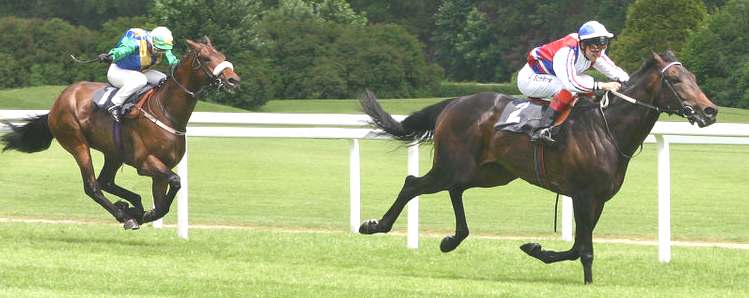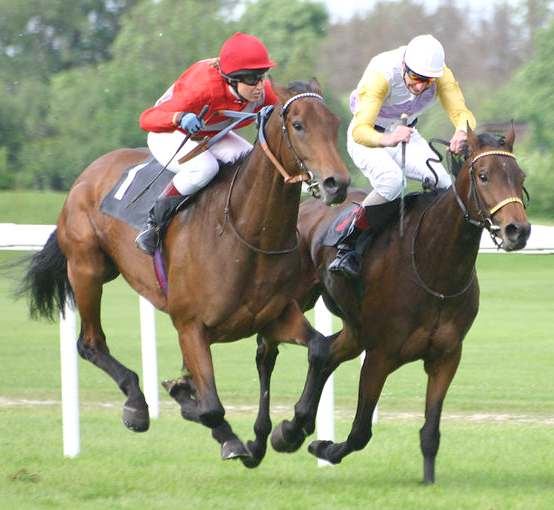|
THOROUGHBRED HORSES
|
|||||||||||||||||||||||||||||||||||||||||||||||||||
|
HOME | BIOLOGY | FILMS | GEOGRAPHY | HISTORY | INDEX | MUSIC | SOLAR BOATS | SPORT | SPONSORS |
|||||||||||||||||||||||||||||||||||||||||||||||||||
The horse must rank high as one of man's closest natural allies. They provided transport for us for hundreds of years. They are also rather beautiful animals with a sense of humour. Fortunes have been made and lost on horses and some have become legends, such as that earthy little fighter Seabiscuit. In times of war, a man and horse together, became the cavalry. A horse is also a companion and a rewarding hobby, or indeed a sporting performance creature, which I'm in favour of, provided the horse is not harmed in any way. Either way they are marvelous creatures, but as with any animal you must look after and love them.
More than a friend
The Thoroughbred is a horse breed developed in 18th century England when English mares were bred with imported Arabian stallions to create a distance racer. Also, "thoroughbred" is an adjective often used by laymen to describe fully-blooded descendants of a particular breed.
The typical Thoroughbred stands 16 hands (64 inches/1.63 m) high, and is bay, brown, chestnut, black or gray/roan in color. The face and lower legs may be marked with white, but white will generally not appear on the body (although certain color genes, usually found in chestnuts, result in white hairs and white patches in the coat—the study of color genetics in horses is an in-depth one). It is the State Horse of Maryland and Kentucky.
Origins
All modern Thoroughbreds descend from three stallions imported to England from the Middle East in the late 17th and early 18th centuries: the Darley Arabian, the Godolphin Arabian, also known as the Godolphin Barb, and the Byerly Turk, together with around 35 mares. (The first part of these stallions' names refers to the stallion's British owner, the second part is an indicator of the horse's origin.)
The first Thoroughbred horse in the American Colonies was Bulle Rock, imported by Samuel Gist of Hanover County, Virginia, in 1730.
Maryland and Virginia were the centers of Colonial thoroughbred breeding.
Thoroughbred race horses
Uses
Although the Thoroughbred is primarily bred for racing, the breed is also used for show jumping and combined training due to its athleticism, and many retired race horses become fine family riding horses, endurance horses, dressage horses, and youth show horses. The larger horses are sought after for hunter/jumper and dressage competitions, whereas the smaller horses are in demand as polo ponies.
The Thoroughbred is bred primarily for racing under saddle at the gallop. Some families of Thoroughbreds are known primarily as sprinters or as distance runners.
Buyers generally select for larger individuals. Longfellow, Man O' War, Secretariat, Phar Lap, Dr. Fager, Silky Sullivan and Forego were famous, big horses, but a substantial number of famous race horses have been small. Aristides, the winner of the first Kentucky Derby was small. Roamer, Round Table, Seabiscuit, Northern Dancer, and more recently, Dalakhani and Smarty Jones, were famous, smaller horses.
Many experts who purchase Thoroughbreds attempt to assess a young horse's potential by observing its overall structural balance, the athleticism and willingness of its walk, the perceived intelligence of its outlook, and the correct conformation of its legs. Buyers of more expensive horses often hire veterinary experts to examine and report on the condition of the horse's breathing apparatus, soundness of bone structure, and size of heart.
Thoroughbreds that are born in the Northern Hemisphere technically become a year older on January first; those born in the Southern Hemisphere turn one on August first. These artificial dates have been set to enable the standardization of races for horses in certain age groups.
Approximately 35,000 Thoroughbred foals are registered each year in the U.S. The largest number of foals are born in Kentucky, Florida, and California. The Thoroughbred industry is a huge agri-business. It supports tens of thousands of jobs in each of these states, from jockeys, trainers, starters, grooms, and kitchen employees at the race track, to farm employees assisting with the birth of foals, the grooming of yearlings, or the growing and preparation of feed, to veterinarians who understand and treat horses, to drivers of horse vans who transport horses across country, to employees of auction houses that specialize in the sale of horses, to employees of companies who develop products to improve the lives of horses and people who work with them. Wagering on races provides purses to the winners and taxes to the state.
Moral Dilemma
Modern thoroughbred racing involves a moral dilemma. The horses are bred for extreme speed, and a primary goal of this breeding has been to decrease bone mass while raising muscle mass, as a horse "carrying" a light skeleton using abnormally strong muscles will travel faster at a gallop than one carrying a relatively heavier bone load. As a result, modern thoroughbreds are muscularly powerful but osteologically delicate creatures. 1.5 of every 1,000 racing starts ends in a career ruining injury (typically in the form of broken leg bones), a ratio far in excess of almost all other human and animal sports. Of those injuries, upwards of 60% are fatal, as horses are routinely "put down" (euthanized) due to the great cost of thoroughbred surgery and rehabilitation which may save the life of the horse but not its ability to compete at a high level. Leg injuries are particularly dangerous because a horse's weight must be distributed as evenly as possible between each of its four legs to prevent circulatory problems, laminitis and other infections which can further endanger life. In the wake of the Barbaro incident in the 2006 Preakness Stakes there were signs that animal rights groups were gearing up to target the thoroughbred industry. The efforts to save the Kentucky Derby winner, however, have evidenced the strides being taken by modern equine surgeons to improve the success rate of these complex operations.
The Thoroughbred in Other Disciplines
A natural athlete, with a generally superb work ethic, the Thoroughbred excels in many equestrian sports. While other breeds are preferred over the Thoroughbred in both dressage and show jumping, the breed can occasionally compete at high levels in dressage, and the Grand Prix ring in show jumping. The flowing, long stridden gaits and good jumping form makes the Thoroughbred a top show hunter as well.
Of all the equestrian sports, the Thoroughbred is probably most suited for eventing, and dominates the highest levels: almost all Olympic horses are full or part-Thoroughbred. The breed is most suited for the cross-country phase, due to its long stride and natural speed, as well as its athletic jump.
Thoroughbreds are also the favorite breed for use in polo. They are seen in the hunt field as well.
The Thoroughbred in Breeding
The Thoroughbred remains one of the most important breeds used in modern horse breeding. They have been incredibly influential on many of the favorite breeds of today, including the American Quarter Horse, the Morgan (a breed that went on to influence many of the gaited breeds in America), the Standardbred, the Irish Horse and many other modern breeds. The Thoroughbred continues to be a favorite as an improver of breeds.
Horse flat racing
POPULAR MAMMALS:
REFERENCE and LINKS:
REFERENCE and LINKS:
A taste for adventure capitalists
Solar Cola - a healthier alternative
|


